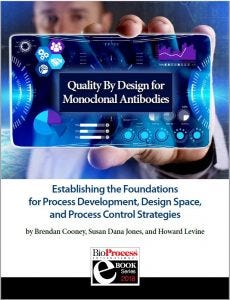eBook: Quality By Design for Monoclonal Antibodies — Establishing the Foundations for Process Development, Design Space, and Process Control StrategieseBook: Quality By Design for Monoclonal Antibodies — Establishing the Foundations for Process Development, Design Space, and Process Control Strategies
 The quality by design (QbD) modernized approach to pharmaceutical development is intended to provide regulatory flexibility, increased development and manufacturing efficiency, and greater room to innovate as well as improve manufacturing processes within defined ranges without obtaining regulatory approval first. QbD is a systematic developmental approach that starts with a clear goal in mind and emphasizes understanding of how variability in both process and materials affects a final product (1).
The quality by design (QbD) modernized approach to pharmaceutical development is intended to provide regulatory flexibility, increased development and manufacturing efficiency, and greater room to innovate as well as improve manufacturing processes within defined ranges without obtaining regulatory approval first. QbD is a systematic developmental approach that starts with a clear goal in mind and emphasizes understanding of how variability in both process and materials affects a final product (1).
Historically, product quality has been assured either with end-product testing (drug products) or with strict and narrow control of manufacturing processes without a comprehensive understanding of how process parameters link to product quality attributes (biologics). According to a 2011 US Food and Drug Administration (FDA) guidance, product quality cannot be assured by testing alone (2). In the QbD paradigm, quality is built into the process rather than being “tested into” a drug product.
This article, combining parts 1 and 2 from BPI’s June and September 2016 issues, presents early steps in process development, including defining a target product profile (TPP), a quality target product profile (QTPP), and critical quality attributes (CQAs). It concludes by focusing on establishing a design space and optimizing process characterization through risk assessment and a well-defined control strategy. The goal of pharmaceutical development is to design a drug manufacturing process that consistently yields a high-quality, safe, and effective product (3). Before 2000, monoclonal antibody (MAb) development and manufacturing tended to be plagued by inefficiencies that resulted in limited innovation throughout a product’s life cycle and significant product waste from lost batches. Some biomanufacturers were unable to connect product attributes to manufacturing processes despite the high risk for waste generated by mistakes. FDA’s 2002 initiative Pharmaceutical CGMP for the 21st Century: A Risk-Based Approach sought to improve interactions between pharmaceutical manufacturers and regulators by focusing on science- and risk-based approaches to development (4). This document states the following:
Continuous improvement is an essential element in a modern quality system, and it aims at improving efficiency by optimizing a process and eliminating wasted efforts in production. In the current system continuous improvement is difficult, if not impossible. Reducing variability provides a win–win opportunity from both public health and industry perspectives; therefore, continuous improvement needs to be facilitated.
The shift toward risk-based development has led to use of iterative risk assessments and QbD methodologies that help improve product and process understanding and increase innovative solutions to manage risk associated with variability inherent in pharmaceutical manufacturing.
The QbD approach provides a set of tools that support both developmental and manufacturing activities. It aligns with the phases of clinical development, enhancing pharmaceutical development processes. ICH guidelines Q8(R2), Q9, Q10, and Q11 provide the framework for QbD (see “ICH” box).
Just fill out the form to view and download the complete eBook.
You May Also Like






